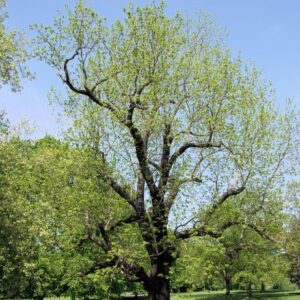Description
Pin Oak Tree (Quercus palustris) 1 Yr Old
The Pin Oak Tree (Quercus palustris) is a fast-growing and adaptable deciduous species native to North America. Known for its symmetrical shape, graceful branching, and brilliant red autumn foliage, it’s a popular choice for urban landscapes, parks, and reforestation projects.
1. Botanical Overview
- Scientific Name: Quercus palustris
- Family: Fagaceae
- Growth Zones: Hardy in USDA zones 4–8
- Lifespan: Can live over 100 years in favorable conditions.
- Height and Spread: Reaches 50–70 feet tall with a spread of 25–40 feet.

2. Physical Characteristics
- Leaves: Glossy, dark green leaves with deeply lobed margins that turn vibrant red to scarlet in the fall.
- Shape: Features a distinctive pyramidal crown when young, maturing to a more rounded canopy.
- Bark: Smooth and grayish-brown in youth, developing rougher, ridged bark with age.
- Acorns: Produces small, rounded acorns with shallow caps that are a vital food source for wildlife.
3. Habitat and Growing Conditions
- Soil: Prefers moist, acidic, and well-drained soils but tolerates moderate clay and compacted soils.
- Light: Requires full sun for optimal growth and form.
- Watering: Thrives in wet conditions but adapts well to moderate drought once established.
- Native Range: Found in the eastern and central United States, especially in floodplain areas.
4. Ecological Impact
- Wildlife Benefits: Provides food and shelter for various wildlife species, including birds, squirrels, and deer.
- Flood Tolerance: Excellent for wetland restoration and areas with periodic flooding.
- Air Quality: Contributes to cleaner air by absorbing carbon dioxide and filtering pollutants.

5. Uses and Benefits
- Ornamental Value: Its symmetrical shape and striking fall colors make it a standout choice for residential and urban landscapes.
- Shade Tree: Provides ample shade due to its dense canopy, making it a favorite for parks and streetscapes.
- Erosion Control: Strong root systems help stabilize soil, especially in flood-prone areas.
- Timber: Produces durable hardwood used in furniture, flooring, and veneer.
6. Challenges and Considerations
- Iron Chlorosis: Susceptible to nutrient deficiency (chlorosis) in high-pH soils; thrives best in acidic conditions.
- Growth Habit: Lower branches may droop as the tree matures, requiring occasional pruning.
- Pests and Diseases: Generally hardy but can be affected by oak wilt and leaf spot in certain regions.
7. Cultivation Tips
- Planting: Best planted in early spring or fall, ensuring ample space for its mature spread.
- Pruning: Prune during dormant seasons to maintain a balanced structure and remove dead branches.
- Mulching: Apply mulch around the base to retain moisture and regulate soil temperature.
The Pin Oak Tree is a versatile and striking addition to any property, offering shade, aesthetic beauty, and ecological benefits while thriving in diverse growing conditions.






Reviews
There are no reviews yet.